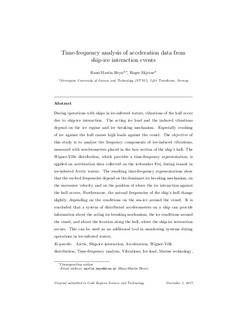| dc.contributor.author | Heyn, Hans-Martin | |
| dc.contributor.author | Skjetne, Roger | |
| dc.date.accessioned | 2019-01-30T12:07:39Z | |
| dc.date.available | 2019-01-30T12:07:39Z | |
| dc.date.created | 2018-09-27T13:48:05Z | |
| dc.date.issued | 2018 | |
| dc.identifier.citation | Cold Regions Science and Technology. 2018, 156 61-74. | nb_NO |
| dc.identifier.issn | 0165-232X | |
| dc.identifier.uri | http://hdl.handle.net/11250/2583089 | |
| dc.description.abstract | During operations with ships in ice-infested waters, vibrations of the hull occur due to ship-ice interaction. The acting ice load and the induced vibrations depend on the ice regime and ice breaking mechanism. Especially crushing of ice against the hull causes high loads against the vessel. The objective of this study is to analyse the frequency components of ice-induced vibrations, measured with accelerometers placed in the bow section of the ship's hull. The Wigner-Ville distribution, which provides a time-frequency representation, is applied on acceleration data collected on the icebreaker Frej during transit in ice-infested Arctic waters. The resulting time-frequency representations show that the excited frequencies depend on the dominant ice breaking mechanism, on the encounter velocity, and on the position of where the ice interaction against the hull occurs. Furthermore, the natural frequencies of the ship's hull change slightly, depending on the conditions on the sea-ice around the vessel. It is concluded that a system of distributed accelerometers on a ship can provide information about the acting ice breaking mechanism, the ice conditions around the vessel, and about the location along the hull, where the ship-ice interaction occurs. This can be used as an additional tool in monitoring systems during operations in ice-infested waters. | nb_NO |
| dc.language.iso | eng | nb_NO |
| dc.publisher | Elsevier | nb_NO |
| dc.relation.uri | https://www.ntnu.edu/samcot | |
| dc.rights | Attribution-NonCommercial-NoDerivatives 4.0 Internasjonal | * |
| dc.rights.uri | http://creativecommons.org/licenses/by-nc-nd/4.0/deed.no | * |
| dc.subject | Arktisk teknologi | nb_NO |
| dc.subject | Arctic Technology | nb_NO |
| dc.subject | Marin kybernetikk | nb_NO |
| dc.subject | Marine cybernetics | nb_NO |
| dc.subject | Isforvaltning | nb_NO |
| dc.subject | Ice Management | nb_NO |
| dc.title | Time-frequency analysis of acceleration data from ship-ice interaction events | nb_NO |
| dc.title.alternative | Time-frequency analysis of acceleration data from ship-ice interaction events | nb_NO |
| dc.type | Journal article | nb_NO |
| dc.type | Peer reviewed | nb_NO |
| dc.description.version | acceptedVersion | nb_NO |
| dc.subject.nsi | VDP::Skipsteknologi: 582 | nb_NO |
| dc.subject.nsi | VDP::Ship technology: 582 | nb_NO |
| dc.source.pagenumber | 61-74 | nb_NO |
| dc.source.volume | 156 | nb_NO |
| dc.source.journal | Cold Regions Science and Technology | nb_NO |
| dc.identifier.doi | 10.1016/j.coldregions.2018.01.019 | |
| dc.identifier.cristin | 1614948 | |
| dc.relation.project | Norges forskningsråd: 223254 | nb_NO |
| dc.relation.project | Norges forskningsråd: 203471 | nb_NO |
| dc.description.localcode | © 2018. This is the authors’ accepted and refereed manuscript to the article. Locked until 8.2.2020 due to copyright restrictions. This manuscript version is made available under the CC-BY-NC-ND 4.0 license http://creativecommons.org/licenses/by-nc-nd/4.0/ | nb_NO |
| cristin.unitcode | 194,64,20,0 | |
| cristin.unitname | Institutt for marin teknikk | |
| cristin.ispublished | true | |
| cristin.fulltext | preprint | |
| cristin.qualitycode | 2 | |

